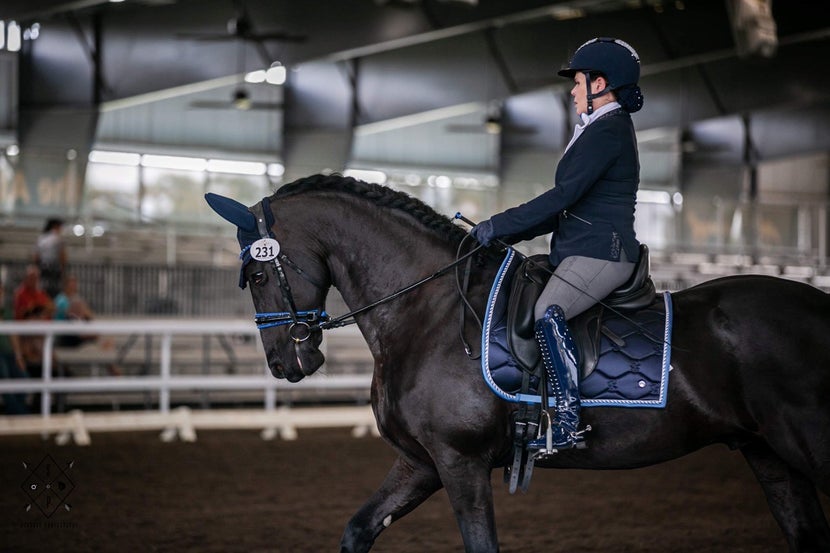Adding Color to the
World of Dressage
A Guide to the Updated USDF Attire Rules
Any equestrian who has come across dressage, whether as a spectator, hobbyist, or active competitor, knows the discipline isn't exactly known for its wide use of the color wheel. Dressage itself is founded from military maneuvers used back in the days of the mounted cavalry. Hence, the traditional dressage "uniform" of black and white. In 2022, the United States Dressage Federation (USDF), made drastic rule changes opening the doors in a big way to what can be worn in competition.
Read on to learn more about what exactly can be worn in the show ring with these updated rules to make the best-informed decision when choosing your next dressage look.

Photo by Kristen Scott of www.sunsoarphotography.com
Updated Attire Rules Explained
The updated attire rules allow for a wide variety of colored show coats to be worn, excluding multicolored, bright colors, and patterns. Subtle pinstripes are allowed, but beyond that, solid colors are going to be your safest choice. Breeches can now be any "non-bright color and without patterns." Shirts and neckwear can now be any color or pattern, as long as the required neckwear or full standup collar is present. The rider's boots and helmets should coordinate or match with the rider's coat. In the past, they had to be the same color or black. Gloves can be any solid color, but white or off-white are still recommended. Until recently, wearing a navy coat in the dressage ring was considered bold, as black and white was the only color pallet in the world of horse ballet.

(Left to Right) Permitted: First, second, and third coats. Not Permitted: Fourth coat and third neckwear.
The first example above, a short riding jacket or cutaway coat (modified tailcoat), is permitted at any level of competition. Traditionally, dressage short coats have four buttons; although, three-button coats are completely acceptable and seen frequently. A tailcoat is permitted only in classes above fourth level.
Any single-color jacket or tailcoat is permitted and may have subtle pin striping, checks, or tweeds. Therefore, the second and third examples would be allowed in USDF shows. Striped or multi-colored jackets or coats are not permitted, so the fourth example may be considered inappropriate with its subtle polka dot pattern.
Tasteful and discreet accents, such as a collar of a different hue, modest piping, or crystal decorations, are acceptable.
White, light, or dark-colored breeches or jodhpurs are all allowed in competition, so the first two examples would now be permitted. Bright colors or patterns are not permitted, so you could not wear the third or fourth examples in the show ring. Contrast piping is allowed.

(Left to Right) Permitted: All when coat is worn; Not Permitted: Third and fourth shirt when coats have been waived.
All of the above shirts would be allowed while worn under a coat. The third patterned shirt would require neckwear that covered the pattern. If jackets or coats are not worn, shirts must be without bold patterns. This means that the third and fourth examples would not be permitted.
Shirts with tie, choker, stock tie, or integrated stand-up collar are required. Ties, chokers, or stock ties may be any color and may have subtle patterns. All of the above examples should be allowed. Shirts with exposed zipper-style collars should use a tie or stock tie.

Rider in traditional dressage attire.

Rider adhering to updated USDF rules. (Photo by Kristen Scott of www.sunsoarphotography.com)
For Better or Worse?
As all equestrians know, riders can struggle to be seen as athletes in the public eye. A more athletic and interesting look could help bridge this gap in public opinion. Individual style can catch the eye of any viewer, even those unfamiliar with the sport. That fun-colored turquoise show coat could attract the attention of someone new who may grow to become an avid spectator.
An opposing viewpoint says that having the rider's legs and hands in bright, clean white guides the judge's eye to the softness of how the rider's seat and hands interact with the horse. The remaining clothing and tack being black or a neutral color keep from distracting the viewer's eye from what is happening underneath the rider in the horse itself. As any dressage rider knows, the goal is for the horse to shine with a rider that melts into that beautiful picture rather than standing out.
The best question to ask when choosing your dressage ring look is, "Do I want to bring the judge's attention there?" If you choose to ride in helmets or boots with crystal accents, the shine will show how often you look down or your leg swings. On the other hand, if a neutral or soft color is worn, the judge may not notice that small flaw. Inversely, if you have a soft and beautiful seat, black breeches on your black saddle keep attention away from the developed skill that was so hard-earned. Always think of the risks and rewards when choosing your look.

Closing Thoughts
The reaction to these changes appears to be mixed. Some find the broad range of colors gaudy and would like to see things stay rooted in tradition, while others are excited about the possibilities for personal expression. As in all sports, style evolves just like the equipment technology, though it can be a bit more challenging to accept when it changes how the sport looks at first glance.
In theory, a rider's outfit that is overly vibrant can draw attention away from the horse, but personal touches in style are more memorable. With the new rule changes, riders have the freedom to wear whatever style makes them feel their best, whether classic or modern. So, what will you be wearing down centerline?

